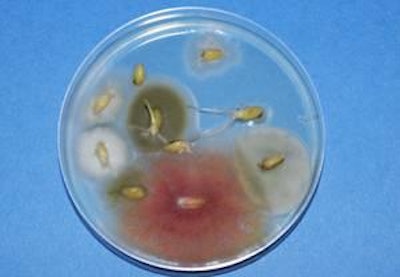
Vomitoxin, more commonly known as DON originates from the mold Fusaruim gramineanum. It infects cereal grains (wheat barley and oats) in addition to corn and sorghum. Growth on the grain kernel is dependent upon high moisture and warm conditions at the time of flowering for wheat or late in the growing season for corn and sorghum.
During the 2009 season, there were several areas in Europe and the U.S. that experienced climatic conditions precipitating a high level of infection. Water-logged soils prevented early harvesting thus allowing more time for the mold to grow. Other molds that are closely associated with DON are T-2 toxin (hemorrhagic changes) and zearalenone (reproductive dysfunction in sows).
Corn grain from the 2009-2010 harvest in the region from Iowa to the east coast was infected by DON. Although the other fusariummolds are often present in grains, DON is the greatest concern from the 2009 crop. Infected corn has a salmon or pink color of the ear at the tip, although shelled corn may look normal. Most elevators apply a rapid test for DON but a more comprehensive laboratory procedure (HPLC) is used to determine the presence of other molds and is highly recommended although expensive.
Infected wheat develops a scab and the kernel is thin and light in weight. Screening grain removes much of the toxin as it is concentrated in the fines and bran component of wheat. Mold toxin is water soluble and thus concentrates in processed grain-by-products and is present at a level three times higher in wheat bran or in the DDGS products available for livestock feeds compared to the original grain.
Although all livestock are sensitive to DON, pigs are the most sensitive species and gestating sows and piglets should be fed the best quality grains. Typically anorexia or feed refusal is observed when DON is present. When pigs consume contaminated feed at a high level of intake emesis (vomiting) occurs hence the name “vomitoxin” attributed to this mycotoxin.
DON is not a mold produced during storage if corn is properly dried to less than 14% moisture and the bins are aerated and the corn is held at under 45°F. There are several products on the market with value to increase feed intake and weight in pigs. Research is continuing on several products with growing pigs to determine the most effective additive for swine diets.

















